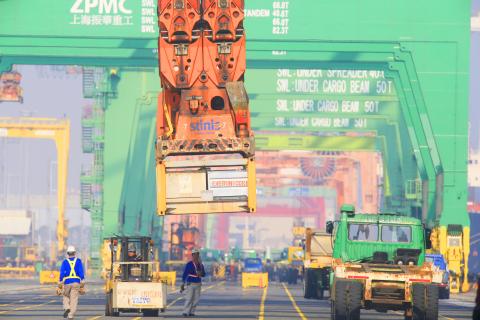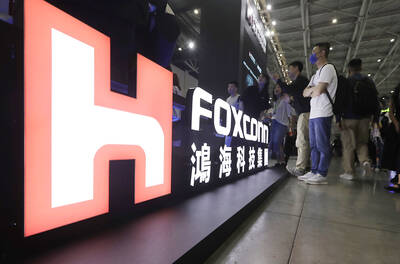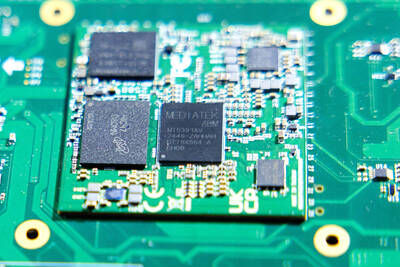The nation’s exports declined 13.9 percent year-on-year last month, as the ongoing economic slowdown in China weakened demand for electronics ahead of the Lunar New Year and low crude prices dampened oil-related shipments, the Ministry of Finance said yesterday.
Outbound shipments dropped to a six-year low of US$22.06 billion last month and might remain sluggish in the coming months due to holiday disruptions and a relative high base in the first quarter of last year, the ministry said.
“The landscape might become clearer in March, when technology firms might start to build up inventory for next-generation devices,” Department of Statistics Director-General Yeh Maan-tzwu (葉滿足) told reporters.

Photo: CNA
Investors’ conferences next week by chipmaker Taiwan Semiconductor Manufacturing Co (台積電) and camera lens supplier Largan Precision Co (大立光) might shed some light on the industry’s order visibility going forward, Yeh said.
The latest export data suggested that inventory adjustments had yet to come to an end, as evidenced by a 7.3 percent decline in electronic shipments and a 31 percent slump in optics exports, she said.
Media reports that Apple Inc may cut production of its iPhone 6S handsets by 30 percent this year due to lackluster sales cast a shadow on earnings outlook for Taiwanese firms in the tech giant’s supply chain, the ministry said.
Imports shrank more than exports last month, falling 15.6 percent year-on-year to US$17.89 billion and widening from a 13.7 percent fall in November, ministry data showed.
The ministry attributed the weakness to companies’ reluctance to replenish raw material and electronics stocks amid a slowing demand.
That left a trade surplus of US$4.17 billion for last month, a 5.6 percent decrease from the same period a year earlier, the ministry said.
For the whole of last year, Taiwan’s exports fell 10.6 percent from 2014 and imports plunged 16.5 percent year-on-year, both faring slightly weaker than the government’s forecasts made in November.
The declines in exports came as all trading partners of Taiwan tightened their belts, as shipments plummeted 12.3 percent to China (including Hong Kong), 14.6 percent to Southeast Asia, and 1.7 percent to the US, while exports also dropped 3.1 percent to Japan and 11 percent to Europe, the ministry said.
The poor data reflected a continued slowdown across the world in which downside risks loom larger than expected earlier, Yeh said.
Expectations that oil prices will soon stabilize appear unlikely to be realized, as oil exporting nations refuse to rein in the supply glut, she said.
A lack of knockout innovations and growing competition from technology firms in China raise further uncertainty about Taiwan’s export outlook, the ministry said.
Taiwan Institute of Economic Research (台經院) economist Gordon Sun (孫明德) said that exporters in Taiwan are facing fierce challenges ahead.
Apart from the rise of the fast-growing Chinese electronic components makers, the depreciation of the yen and the euro will also have a negative impact on the competitiveness of Taiwanese exporters, Sun said.

Leading Taiwanese bicycle brands Giant Manufacturing Co (巨大機械) and Merida Industry Co (美利達工業) on Sunday said that they have adopted measures to mitigate the impact of the tariff policies of US President Donald Trump’s administration. The US announced at the beginning of this month that it would impose a 20 percent tariff on imported goods made in Taiwan, effective on Thursday last week. The tariff would be added to other pre-existing most-favored-nation duties and industry-specific trade remedy levy, which would bring the overall tariff on Taiwan-made bicycles to between 25.5 percent and 31 percent. However, Giant did not seem too perturbed by the

Foxconn Technology Co (鴻準精密), a metal casing supplier owned by Hon Hai Precision Industry Co (鴻海精密), yesterday announced plans to invest US$1 billion in the US over the next decade as part of its business transformation strategy. The Apple Inc supplier said in a statement that its board approved the investment on Thursday, as part of a transformation strategy focused on precision mold development, smart manufacturing, robotics and advanced automation. The strategy would have a strong emphasis on artificial intelligence (AI), the company added. The company said it aims to build a flexible, intelligent production ecosystem to boost competitiveness and sustainability. Foxconn

TARIFF CONCERNS: Semiconductor suppliers are tempering expectations for the traditionally strong third quarter, citing US tariff uncertainty and a stronger NT dollar Several Taiwanese semiconductor suppliers are taking a cautious view of the third quarter — typically a peak season for the industry — citing uncertainty over US tariffs and the stronger New Taiwan dollar. Smartphone chip designer MediaTek Inc (聯發科技) said that customers accelerated orders in the first half of the year to avoid potential tariffs threatened by US President Donald Trump’s administration. As a result, it anticipates weaker-than-usual peak-season demand in the third quarter. The US tariff plan, announced on April 2, initially proposed a 32 percent duty on Taiwanese goods. Its implementation was postponed by 90 days to July 9, then

AI SERVER DEMAND: ‘Overall industry demand continues to outpace supply and we are expanding capacity to meet it,’ the company’s chief executive officer said Hon Hai Precision Industry Co (鴻海精密) yesterday reported that net profit last quarter rose 27 percent from the same quarter last year on the back of demand for cloud services and high-performance computing products. Net profit surged to NT$44.36 billion (US$1.48 billion) from NT$35.04 billion a year earlier. On a quarterly basis, net profit grew 5 percent from NT$42.1 billion. Earnings per share expanded to NT$3.19 from NT$2.53 a year earlier and NT$3.03 in the first quarter. However, a sharp appreciation of the New Taiwan dollar since early May has weighed on the company’s performance, Hon Hai chief financial officer David Huang (黃德才)